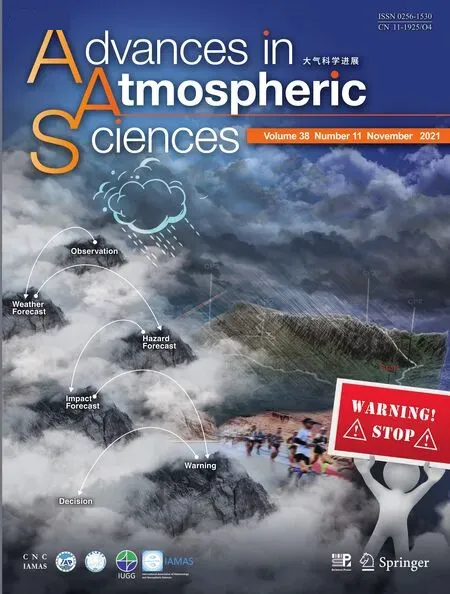Evaluation of Surface Relative Humidity in China from the CRA-40 and Current Reanalyses
2021-09-13JingpengZHANGTianbaoZHAOZhiLIChunxiangLIZhenLIKairanYINGChunxiangSHILipengJIANGandWenyuZHANG
Jingpeng ZHANG ,Tianbao ZHAO ,Zhi LI ,Chunxiang LI ,Zhen LI ,Kairan YING ,Chunxiang SHI,Lipeng JIANG,and Wenyu ZHANG
1College of Natural Resources and Environment, Northwest A &F University, Yangling, Shaanxi 712100, China
2CAS Key Laboratory of Regional Climate-Environment Research for Temperate East Asia (REC-TEA), Institute of Atmospheric Physics (IAP), Chinese Academy of Sciences (CAS), Beijing 100029, China
3National Meteorological Information Center, China Meteorological Administration, Beijing 100081, China
4School of Geoscience and Technology, Zhengzhou University, Zhengzhou, Henan 450001, China
ABSTRACT Recently,the China Meteorological Administration (CMA) released a new Global Atmospheric Reanalysis (CRA-40)dataset for the period 1979−2018.In this study,surface relative humidity (RH) from CRA-40 and other current reanalyses(e.g.,CFSR,ERA5,ERA-Interim,JRA-55,and MERRA-2) is comprehensively evaluated against homogenized observations over China.The results suggest that most reanalyses overestimate the observations by 15%−30% (absolute difference) over the Tibetan Plateau but underestimate the observations by 5%−10% over most of northern China.The CRA-40 performs relatively well in describing the long-term change and variance seen in the observed surface RH over China.Most of the reanalyses reproduce the observed surface RH climatology and interannual variations well,while few reanalyses can capture the observed long-term RH trends over China.Among these reanalyses,the CFSR does poorly in describing the interannual changes in the observed RH,especially in Southwest China.An empirical orthogonal function(EOF) analysis also suggests that the CRA-40 performs better than other reanalyses to capture the first two leading EOF modes revealed by the observations.The results of this study are expected to improve understanding of the strengths and weaknesses of the current reanalysis products and thus facilitate their application.
Key words:surface relative humidity,CRA-40 reanalysis,current reanalysis,evaluation
1.Introduction
Water vapor plays an important role in the global hydrological and energy cycles and atmospheric circulation through its major effect on the changes in precipitation and temperature under global warming (Byrne and O’Gorman,2016).Relative humidity (RH) is the ratio of the partial pressure of water vapor to the pressure of the saturation water vapor at a given temperature and thus is highly sensitive to temperature changes.RH is often used as an important indication in weather and climate monitoring research because RH can quantify how much water vapor is in the air compared with the maximum possible water vapor the air can hold before condensing (Li et al.,2020b).In addition,understanding long-term trends and variations in RH will reduce the uncertainty in future climate predictions (Bojinski et al.,2014;Vicente-Serrano et al.,2018).RH also plays a significant role in discriminating fog and haze,which directly affects the atmospheric particulate concentration and atmospheric visibility,which in turn has a great influence on the thermal comfort index and even human health (Jin and Meng,2017).
Many studies have investigated RH change and variability through multiple observational data sets in recent years.On a global scale,the land average RH shows a gradual increase for the period of 1973−2000,followed by a steep decline during 2000−15 based on the land observation dataset,HadISDH (Dunn et al.,2017).However,Dai (2006)examined RH trends using the observational data from 15000 weather stations and ships and found a statistically significant declining trend in RH for global oceans but no significant trend over land during 1976−2004.Gaffen and Ross(1999) showed a slight positive trend in the United States during 1961−95,while van Wijngaarden and Vincent (2005)found that RH decreased with rapid warming by several percent in the spring for 1953−2003 in the west of Canada.For North America as a whole,surface RH has decreased from 1948 to 2010 (Isaac and Van Wijngaarden,2012).Similar drying trends in RH have also been found in other regions and countries such as India (Dai,2006),Iran (Kousari et al.,2011;Valipour,2015),and Spain (Espadafor et al.,2011;Vicente-Serrano et al.,2014).Decreases in surface RH are also seen for most of China from 1961 to 2010,except parts of central and eastern China,and there is an especially sudden decrease after 2003 (Song et al.,2012).This sudden change over China is likely a result of an instrument change in the observation system (Yu and Mou,2008;Yuan et al.,2010;Zhao et al.,2012,2015).In addition,station relocations,observational practices,processing procedures,and other related issues can induce spurious long-term trends in humidity records (Zhao et al.,2012,2015;Zhu et al.,2015).Recently,some efforts (e.g.,Dai et al.,2011;Zhao et al.,2015;Li et al.,2020b) have been made to adjust the discontinuities caused by instrument changes in observed humidity records,and this has provided homogenized long-term RH records for climate research such as reanalysis construction,model evaluations,and satellite calibration.
Climate reanalysis datasets have been widely used to investigate atmospheric RH variations and water vapor changes.However,the reanalysis products are still suboptimal or even unusable for climate applications due to the fact that even though the assimilation system remained fixed,changes in the observing systems produced spurious changes in the perceived climate (Trenberth et al.,2001;Bengtsson et al.,2004;Zhao and Zhao,2011).For instance,Daoud et al.(2009) found that the largest difference of the RH between the NCEP/NCAR and ERA-40 reanalyses exists in the North Atlantic Ocean,and the ERA-40 does not agree well with the observations from radio-sounding stations.Simmons et al.(2010) showed that RH from the ERA-Interim and ERA-40 products decreased over most of the land,likely due to limited moisture supply from the oceans.Zhao et al.(2015) evaluated water vapor and RH from reanalysis products using homogenized radiosonde observations,and they found that the reanalyses,especially the newer-generation reanalyses (e.g.,JRA55,CFSR,and ERA-Interim) reproduce the observed atmospheric humidity climatology and interannual variations over China well,while few reanalyses capture the observed long-term changes.Other studies (e.g.,Bao and Zhang,2013;You et al.,2015) have also suggested that the uncertainties in RH among different generation reanalyses are still considerable over China,especially in Southwest China.Besides these,few studies have examined the reliability of RH changes and long-term trends from the latest reanalysis products(e.g.,ERA5,MERRA-2) over China.
Recently,the China Meteorological Administration released a new-generation 40-year (from 1979 to 2018)global atmosphere reanalysis,CRA-40 (Liu et al.,2017;Liao et al.,2021).Compared with other reanalyses,more traditional observation and satellite datasets,especially over East Asia,have been assimilated into CRA-40 (Wang et al.,2018;Yin et al.,2018) for the purpose of weather and climate research over East Asia.Some recent studies have evaluated the CRA-40 along with the 10-yr (2007−16) interim(CRA-Interim) products (e.g.,Li et al.,2020a,2021;Liang et al.,2020;Yu et al.,2021).The results show that CRA-40 and CRA-Interim perform well among the current reanalysis products in terms of global energy cycle,daily precipitation,land surface variables,and the Asian subtropical westerly jet.How well the CRA-40 describes the observed variations and long-term changes in surface RH over China is thus of great concern in this study.
In this study,we comprehensively examine the performance of the CRA-40 and other current generation reanalyses (e.g.,CFSR,ERA-Interim,ERA5,JRA-55,and MERRA-2) in reproducing the climatology and long-term variations and trends in surface RH against homogenized observations over China.The results of this study are expected to help in understanding the strengths and weaknesses among these reanalyses and to further facilitate their applications in climate change.The organization of this paper is as follows.Section 2 describes the observational and reanalysis products and analysis method used in this study.Comparisons between the observations and the six reanalysis products in terms of the biases or errors in the mean climatology,spatiotemporal variations,and long-term trends are made in section 3.An EOF analysis is also performed in section 3.A summary and concluding remarks are given in section 4.
2.Data and method
2.1.Observational data
Changes in instruments,station relocations,observational practice,processing procedures,and other issues may result in spurious changes and discontinuities in raw near-surface RH records (Zhu et al.,2015).These discontinuities can greatly affect the estimation of the interannual variations and long-term trends in RH.Li et al.(2020b) homogenized these daily RH records at 746 National Reference and Basic Stations in the Chinese mainland using the Multiple Analysis of Series for Homogenization (MASH) method(Szentimrey,1999).This method has been widely used to detect and correct inhomogeneities by not assuming reference series are homogeneous (Li et al.,2018).The advantage of this procedure is that possible break points in raw climate series can be detected and adjusted through mutual comparisons of series within the same climatic area.The new version,MASHv3.03,was developed for homogenization of daily series as well as for quality control of daily data and missing daily data completion.After this homogenization,the surface RH exhibits not only temporally more consistent long-term variations but also demonstrates spatially more coherent long-term trends than methods without homogenization.The homogenized data over China are now updated to 2018,and the observational stations are shown in Fig 1.The density of these observational stations is higher in eastern China than in western China,likely resulting in more accurate estimates of regional mean RH for the east than for the west.In addition,the monthly precipitation from the Global Precipitation Climatology Centre (GPCC,Rudolf et al.,2010) in China is used to investigate the correlation between the precipitation and RH.
2.2.Reanalysis products
The reanalysis RH data are obtained from six products:CRA-40,CFSR,ERA5,ERA-Interim,JRA-55,and MERRA-2,which have substantially improved spatiotemporal resolution compared with previous versions of the products.Table 1 summarizes the basic information about these reanalyses,including reference information.The ERA5 has the highest spatial resolution with a grid size of 0.25°×0.25°,followed by the CFSR and ERA-Interim(0.5°×0.5°).The CRA-40 has the lowest resolution with a grid size of 1.0°×1.0°.

Table 1.The six reanalyses used in this study.
The CRA-40 reanalysis is based on the Global System Model (GSM) in the Global Forecast System (GFS) of NCEP and the Gridpoint Statistical Interpolation (GSI) 3-DVar assimilation system.The original output has a spatial resolution of 0.312°×0.312°,with 64 vertical levels.Besides more traditional observations and satellite datasets collected over East Asia,the CRA-40 has also assimilated more observation data of the Integrated Global Meteorological Observation Archive from Aircraft (IGMOAA),mainly adding more Chinese Aircraft Meteorological Data Relay(AMDAR) data.Complex quality control procedures used by NCEP for aircraft observations are applied to detect data errors (Liao et al.,2021).
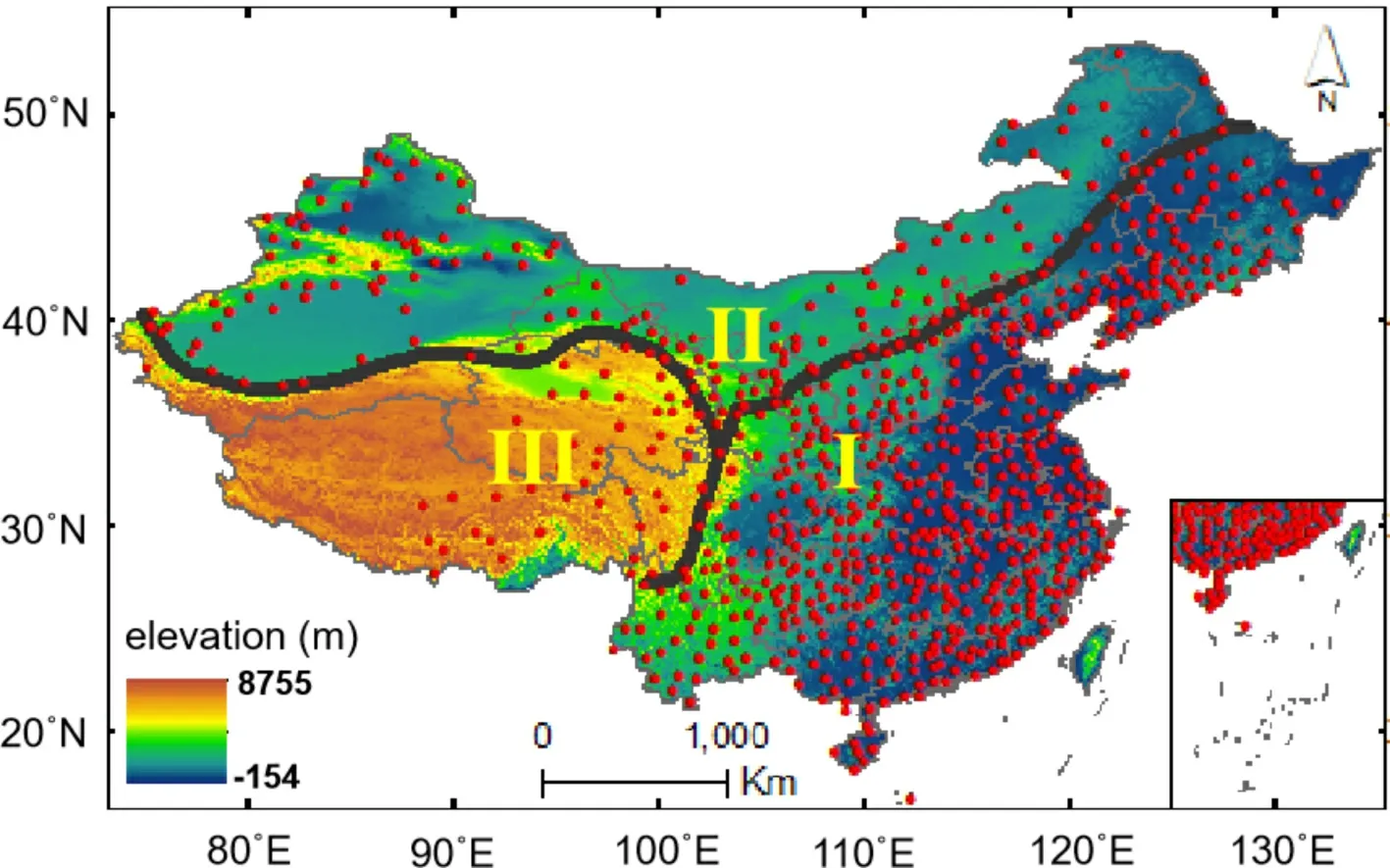
Fig.1.Geographic distribution of the 746 meteorological stations (red dots) over China used in this study and the three subregions:region I as East China (with elevation lower than 1 km),region II as Northwest China (with elevation of 1−3 km),and region III as the Tibetan Plateau (with elevation over 3 km).The lower right-hand illustration shows the South China Sea.
Although each reanalysis was developed with distinct model physics and resolutions to meet specific goals,nearly all of the reanalyses assimilate satellite observations(mainly after 1979) using either a 3-D or a 4-D variational assimilation technique with a constant error covariance matrix for the first-guess fields throughout the reanalysis period.It should also be noted that the near surface RH is not archived directly in the ERA datasets (ERA5 and ERAInterim),thus,the relative humidity is calculated from nearsurface temperature (T) and dew point temperature (Td):RH=es(Td)/es(T)×100,es is the saturation vapor pressure at a certain temperature.
2.3.Data processing
To facilitate the evaluations and comparisons,both the monthly mean and anomalies (relative to the 1979−2018 climatology) are remapped onto a common 1°×1° grid using bilinear interpolation for reanalyses and using the Cressman analysis method (Cressman,1959) for regridding the station observations,respectively.The Cressman interpolation technique with a maximum search radius of 1000 km was used in the gridding of the observational data.Such a radius often represents the typical correlation distance in monthly air temperature and humidity fields and thus is commonly used in gridding temperature and humidity monthly anomaly data (e.g.,Dai et al.,2011).We emphasize that the observational stations are relatively sparse over some areas,such as the western Tibetan Plateau,compared with those in eastern China;thus,the interpolated RH values are less reliable over these regions.By averaging the gridded datasets using the grid-box area as the weighting,the regional mean values are obtained.To facilitate the comparison in subregions with different topography,mainland China was divided into three subregions as in our previous studies (e.g.,Zhao et al.,2015;Zhang and Zhao,2019),which are East China as region I (with elevations lower than 1000 m),Northwest China as region II (with elevations of 1000−3000 m),and Tibetan Plateau as region III (with elevations over 3000 m).
To further examine the impact of the verifying grids on the comparison,both the ranalyses and the observations were also regridded into 0.5°×0.5° grids.We compared the analysis results between the 1°×1° and 0.5°×0.5° grids.The result suggests that differences in the long-term mean,variations,and changes in surface RH between reanalysis products and the observations at two different grids are negligible for a large scale.Thus,the following comparisons are based on a 1°×1° grid.
2.4.Basic statistics
Using the monthly mean and anomalies from the observations and the reanalyses on the common 1°×1° grid,some basic statistics were calculated to assess the performance of each reanalysis product in describing the observed RH mean climatology,spatiotemporal variations,and long-term trends over China during the period of 1979−2018.
The mean bias (B) is defined to assess the absolute difference between the observations and reanalyses averaged during the study period at each grid box:

where Y and X denote the monthly reanalyses and observed RH,respectively,and N is the number of data points during the study period.
The root-mean-square error (RMSE) is defined to measure the average magnitude of the error with a focus on the extreme values:

The Pearson correlation coefficient (r) is used to examine the consistency between the observations and reanalyses:

The statistical significance of the RH trend was tested using the Mann-Kendall Tau nonparametric technique(Mann,1945;Kendall,1975).The Mann-Kendall statistic(S) is calculated as:
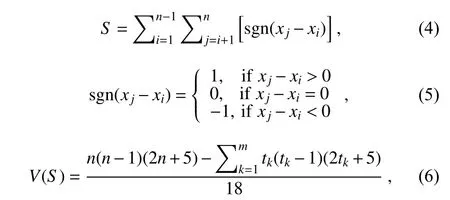
where n is the number of data points and V(S) is the variance of S.m is the number of tied groups,and tkdenotes the number of ties for group k.In cases where the sample size n>10,the standard normal test statistic ZSis calculated as:
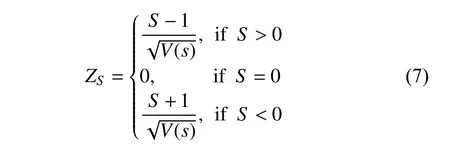
If ZSis greater than zero,it means an upward trend;if ZSis less than zero,it means a downward trend.At the 5%and 1% significance levels,the null hypothesis of no trend is rejected if |ZS|>1.96 and |ZS|>2.576,respectively.
To explore the differences of variability,skewness,and shape of RH distributions from the observations and reanalysis products,we use smoothed histograms estimated from the monthly RH anomalies at all given grids for China as a whole and three subregions.The histograms are derived using cubic spline fitting smoothed during 1979−2018(1980−2018 for the MERRA-2).The monthly anomalies of RH are normalized at each grid box using the standard deviation of the 1979−2018 period (1980−2018 for the MERRA-2) before regional averaging.In addition,an empirical orthogonal function (EOF) analysis is utilized to examine how well each current reanalysis can capture the spatiotemporal variations and the leading modes displayed by observed surface RH.
3.Results
3.1.Climatological bias
Figure 2 displays the spatial distribution of the differences between the reanalysis and observed surface RH for the annual,warm season (April to September),and cold season (October to March) means over China from 1979 to 2018 (1980−2018 for the MERRA-2).It is clear that most reanalyses overestimate the observations by 15%−30% over the Tibetan Plateau,while they underestimate the observations by 5%−10% over most of northern China.In particular,wet biases in the CRA-40,CFSR,and MERRA-2 can reach from–5% to–25% over northwestern China.Relative to the observed long-term means over eastern China,the biases from the ERA5,ERA-Interim,and JRA-55 are generally within~5% (Figs.2g−o),while wet biases from~5% to 10% exist in the CFSR and MERRA-2 over southeastern China (Figs.2d−f and p−r).Among these reanalysis products,the CRA-40 is the driest compared to the observations with a bias of~5%−25% over most of China,except the Tibetan Plateau and the northern part of northeastern China (Figs.2a−c).The large wet biases over southwestern China likely result from the fact that the observed stations are relatively sparse over the Tibetan Plateau and that the gridded data were interpolated from the surrounding stations with lower elevations,which leads to less reliable interpolated RH values over these regions.From the perspective of the national regional average (Table 2),the RH from the MERRA-2 has a lower bias than that from the other reanalyses,especially for the annual and warm season.In contrast,the CFSR has a larger bias,especially for the annual and cold season.Table 2 also suggests that most reanalysis products are successful in reproducing the spatial variations of the observations with pattern correlations of 0.67−0.92.Among the six reanalysis products,the MERRA-2 is the best to describe the observed spatial variations,not only in annual but also in warm and cold seasons (with a pattern correlation of 0.83−0.92).Although a similar assimilation system is utilized for the CFSR and CRA-40,the CFSR is the worst in reproducing the observed spatial pattern (with a pattern correlation of 0.67−0.84).Furthermore,the pattern correlations in the warm season are generally higher than those in the cold season.

Table 2.The pattern correlations of the reanalyses with their regional-averaged biases (reanalysis minus observation) for annual,warm season (April to September),and cold season (October to March) over China during 1979−2018 (1980−2018 for the MERRA-2).All pattern correlations are significant according to the two-sided Student's t test (p <0.01).
Figure 3 shows that the RMSE of the reanalyses with respect to the observations is about 2%-4% for most of eastern China but over 10% in most of northwestern and southwestern China,largely following the terrain features of China.In particular,the RMSE reaches 20% or more over the Tibetan Plateau,where the observed RH is relatively less reliable due to sparse observations.The CRA-40,CFSR,and MERRA-2 show larger RMSE over most of China compared to the other products.This suggests that despite assimilating more observations over China,the newergeneration CRA-40 reanalysis dose not clearly show reduced RMSE in surface humidity over China.
The zonal and meridional means of monthly mean surface RH show a consistent variation along the west−east and south−north directions (Fig.4).The driest air with RH of~35%−55% is seen in the hinterland of the Taklimakan Desert (40°N,85°E).In addition,most reanalyses are wetter than observed in the areas north of 50°N,east of 120°E(located in northeastern China),south of 35°N (including the Tibetan Plateau and south of the Yangtze River),and west of 80°E (Pamir Plateau) but are drier than the observations in the northern areas of the Yangtze River (35°−50°N,105°−115°E).This is consistent with the biases and RMSE as shown in Figs.2 and 3.
Figure 5 presents the month−years evolution of the surface RH for the observations and reanalyses averaged over China during 1979−2018 (1980−2018 for the MERRA-2).It can be seen that the temporal evolution in the surface RH from most reanalyses is broadly consistent with the observed result (r ≥ 0.75;except for the CFSR).The RH is often greatest in August,declining to its lowest in April.In particular,the ERA5,ERA-Interim,and JRA-55 are more consistent (r ≥ 0.89) with the observations than the other products.By contrast,the CFSR still performs poorly in presenting the month−years evolution seen in the observed surface RH with a pattern correlation of 0.27 (Fig.5c).
Histograms are often used to demonstrate how the variability,the skewness,or the shape of the distribution of a climate variable may change in a particular region over a specific period (Cubasch et al.2013).Figure 6 exhibits the histograms of regionally averaged surface RH anomalies smoothed using cubic spline fitting.To improve the spatial comparability,the local RH anomalies are first normalized by their climatology for 1979−2018 (1980−2018 for the MERRA-2).It is clear that the RH anomalies largely follows a Gaussian distribution,and the shapes of the smoothed histograms from reanalyses are quite consistent with the observations for the whole of China and the three subregions.Consistent with previous results,the shapes of the CFSR histograms are flatter,with an increased spread and reduced peak,than those derived from the other reanalyses and observations;this is especially clear in the Tibetan Plateau.
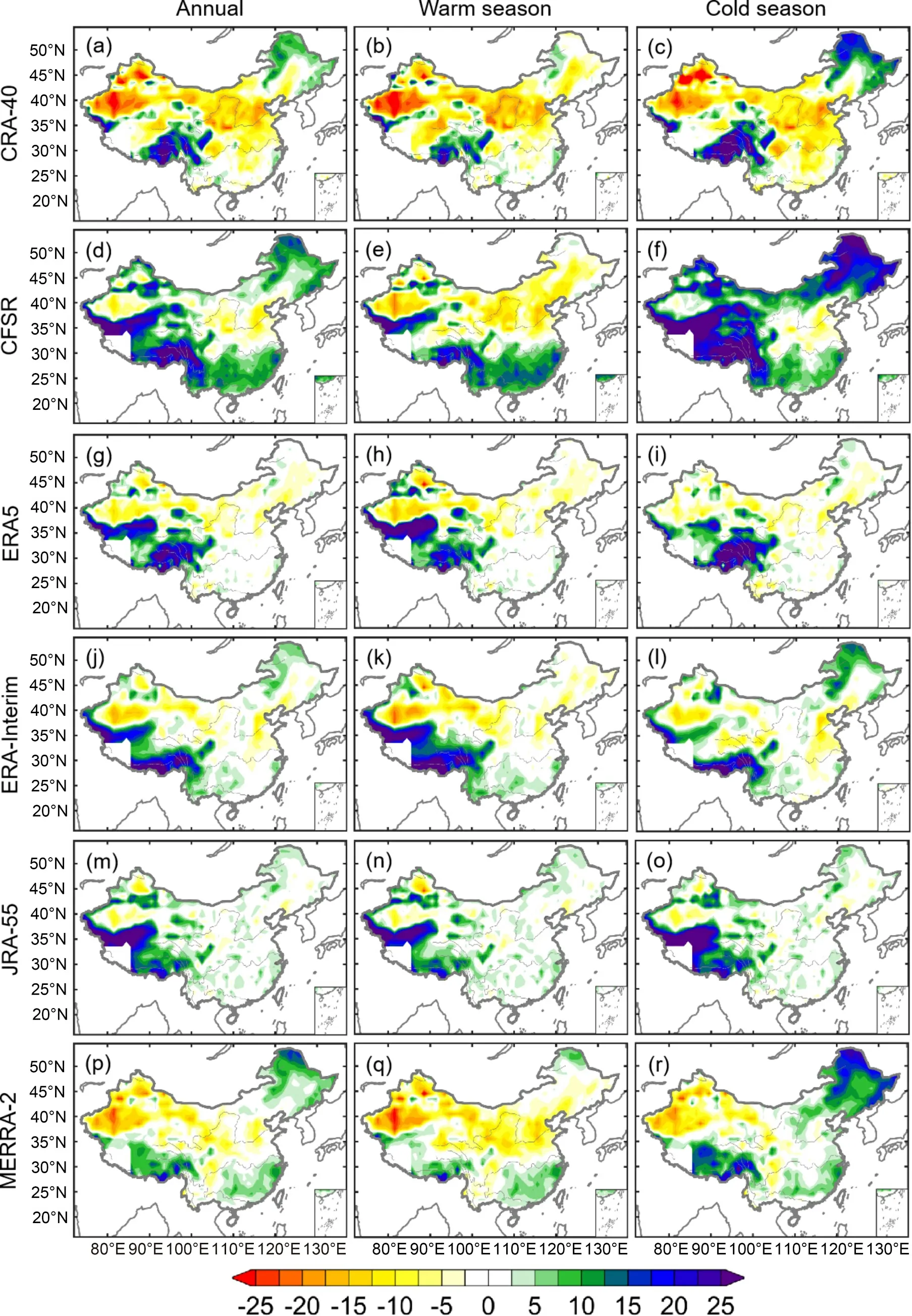
Fig.2.Bias distributions of long-term mean surface RH between reanalyses and observations (%;reanalyses minus observations) during 1979−2018 (1980−2018 for the MERRA-2).Biases of (a−c) CRA-40,(d−f) CFSR,(g−i) ERA5,(j−l) ERA-Interim,(m−o) JRA-55,(p−r) MERRA-2 for annual (left),warm season (middle),and cold season (right)over China.
3.2.Correlation and trend analysis
Figure 7 shows the spatial distribution of the correlations between the reanalyses and the observed monthly RH anomalies over China for 1979−2018 (1980−2018 for the MERRA-2).It is clear that most reanalyses perform better in representing the temporal variations of the observed RH in eastern China (r >0.60),especially over areas around the lower reaches of the Yangtze River and the Yellow River(r >0.70).In particular,the ERA5 and JRA-55 both are more highly correlated with the observations (r >0.90) than the rest of reanalysis products over most of eastern China.As shown by the above analysis,the CFSR is the least correlated to the observations over western China,especially for the Tibetan Plateau.
To further examine the performance of the current reanalysis products in capturing surface RH,we utilized the GPCC precipitation dataset to evaluate the correlation between precipitation and surface RH.The correlations between the observed monthly precipitation and surface RH anomalies are more than 0.5 for most of China.In particular,the correlations are more than 0.6 in the northwest part of Xinjiang province and some parts of northeastern and southeastern China (Fig.8a).Among these reanalysis products,the surface RH from the MERRA-2 is more strongly correlated (r=0.5−0.8) with the observed precipitation than the other products for most of China (Fig.8g).Except the MERRA-2,the surface RH anomalies from other reanalysis products are weakly correlated with the observed precipitation over most of China (r ≤ 0.40),especially for many areas of northwestern China and the Tibetan Plateau.
To examine the interannual variations and long-term changes in RH,Fig.9 displays the time series of the surface RH annual anomalies from the observations and reanalyses averaged over the whole of China and the three subregions (cf.Fig.1).It is clear that the surface RH interannual variations in most reanalysis products,except the CFSR,are highly consistent with the observations over China.The CRA-40,ERA5,and JRA-55 are better than other reanalyses in describing the observed RH variations over the whole of China and the three subregions (r=0.42−0.83;Table 3);the CRA-40 performs especially well over eastern China (r=0.83).Consistent with Fig.8,the CSFR and ERA-Interim are less correlated with the observed series than the other reanalyses over northern China and the Tibetan Plateau (i.e.,regions II and III;Table 3).In terms of the three subregions,relatively low correlations between the observations and the reanalyses are seen over the Tibetan Plateau (Table 3).In contrast with the GPCC precipitation,the surface RH changes from most of the reanalysis products(except the CFSR) are highly consistent with the observed precipitation changes,and the MERRA-2 performs best among these reanalyses in depicting the long-term changes in the observed precipitation with a correlation of 0.53−0.62.
Figure 10 shows the spatial patterns of the long-term RH linear trend derived from the reanalyses and the observations over China during the study period.Largely following the Clausius-Clapeyron equation (Trenberth et al.,2003,2005),the observed RH changes are often small for most of China (Fig.10a).This is broadly consistent with the atmospheric RH long-term changes derived from the radiosonde data (Zhao et al.,2011,2015).However,none of the reanalyses can reproduce the observed trend pattern well (pattern correlations are less than 0.38),and the reanalyses themselves differ substantially among themselves.In contrast to the observed weak trends,spurious drying trends over eastern China are seen in the CFSR,ERA5,ERA-Interim,and JRA-55,even though they perform well in depicting the observed RH variations in these areas.The MERRA-2 does relatively better to roughly capture the observed RH trend patterns with comparable magnitudes of upward trends over most of China (with a significant pattern correlation of 0.38) and for the three subregions (Table 3).Broadly consistent with the long-term changes in atmospheric precipitable water (Zhao et al.,2015),the newer-generation reanalyses are hardly to capture the long-term trends in the observed surface RH changes over China.

Table 3.The correlation coefficients (R) of the monthly surface RH anomalies between the observations and the reanalyses averaged over the whole of China and the three subregions outlined in Fig.1,along with the regional mean trends [% (10 yr)–1)]estimated from the monthly surface RH anomalies.Numbers in bold are statistically significant at the 5% level,while the numbers denoted with * are statistically significant at the 1% level according to the two-sided Student's t test.
In summary,most reanalysis products can describe the interannual variations in observed surface RH over eastern and northern China well but exhibit relatively poor performance over western China,especially over the Tibetan Plateau.Few reanalyses can capture the observed long-term RH trends,and the reanalyses themselves differ substantially from each other.In general,the CRA-40,a newer-generation reanalysis,performs well in depicting the interannual variations seen in the observed surface RH over China since 1979.
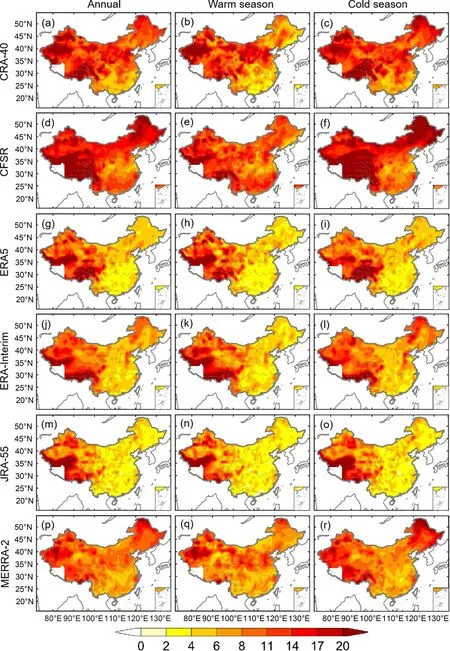
Fig.3.Spatial distributions of root-mean-square error (RMSE,%) of the monthly surface RH between the reanalyses and the observations during 1979−2018 (1980−2018 for the MERRA-2).RMSE for (a−c) CRA-40,(d−f) CFSR,(g−i)ERA5,(j−l) ERA-Interim,(m−o) JRA-55,(p−r) MERRA-2 for annual (left),warm season (middle),and cold season(right) over China.
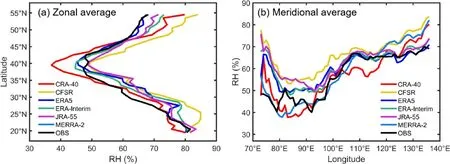
Fig.4.(a) Zonal and (b) meridional average of monthly mean surface RH from the observations and the reanalyses for the 1979−2018 period (1980−2018 for the MERRA-2) over China.

Fig.5.Month-year evolution of the surface RH for the observations and the reanalyses averaged over China from 1979 to 2018 (1980−2018 for the MERRA-2).The pattern correlation (R) between the reanalyses and the observations is also shown in (b−g).The pattern correlations of each reanalysis are statistically significant at the 5% level.
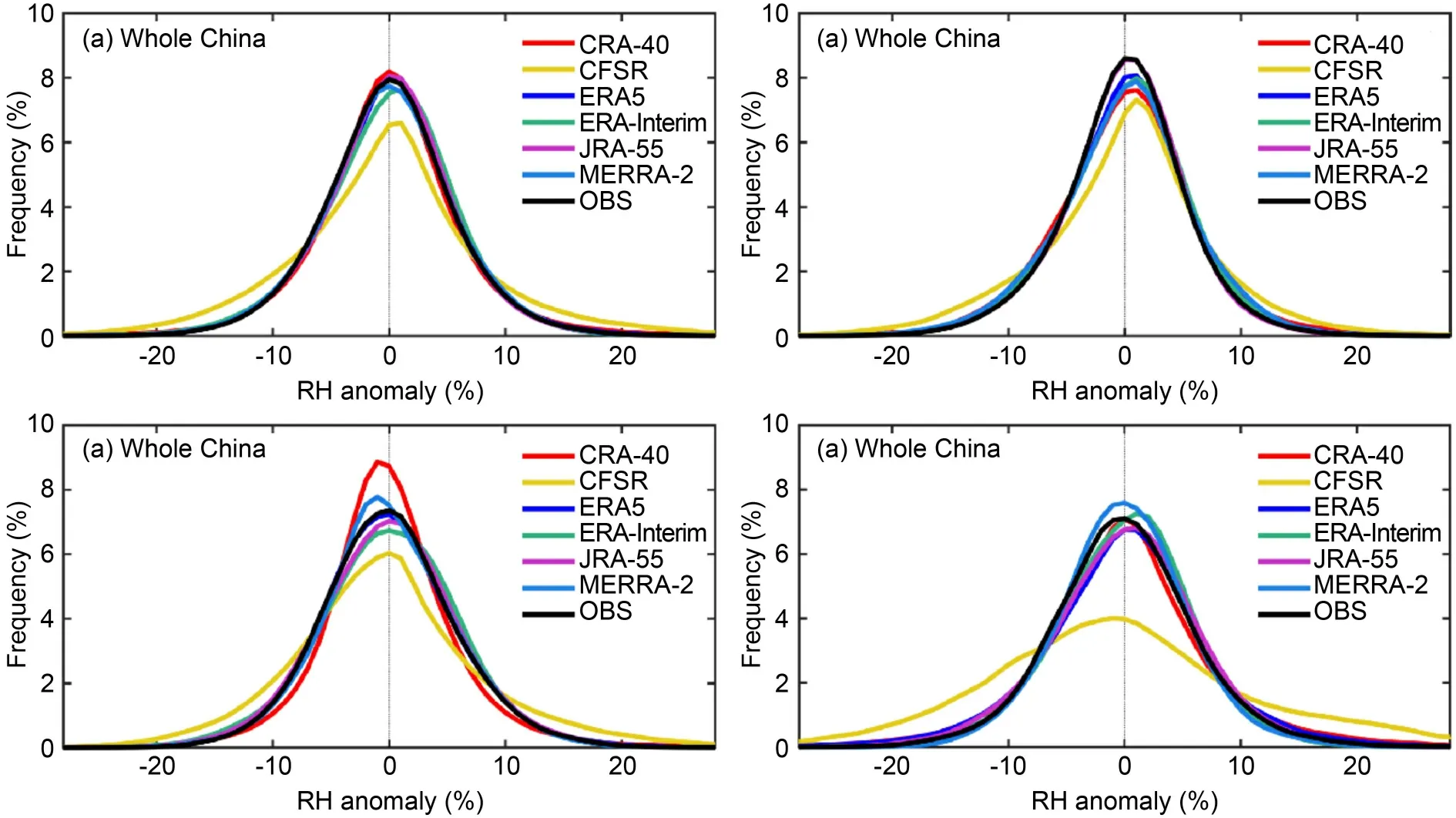
Fig.6.Histograms of the monthly RH anomalies for all grid boxes over (a) the whole of China and (b−d) the three subregions outlined in Fig.1.The histograms are derived using cubic spline fitting smoothed during 1979−2018 (1980−2018 for the MERRA-2).The monthly anomalies of RH are normalized at each grid box using the standard deviation of the 1979−2018 period (1980−2018 for the MERRA-2) before regional averaging.The rate of RH anomaly is binned at 1%intervals.
3.3.EOF analysis
To provide further insight into how well the reanalyses can capture the spatial and temporal variations of the observed surface RH,an EOF analysis was conducted based on the monthly RH anomalies (normalized by the local standard deviation and square root of the cosine of the latitude).Figures 11 and 12 display the spatial patterns and the principal components (PCs) for the first two leading EOFs of the observations and reanalyses,which together account for 33.3%−39.1% of the total variance.
As shown in Fig.11,the first EOF modes derived from the observations and reanalyses all show patterns with the same sign over the whole of China and have the largest magnitudes contributed from central East China.The PC time series of this mode depicts the main feature of the nationwide-average RH anomalies,which is largely related to the long-term variations of RH shown in Fig.9a.Overall,the first EOF modes derived from the reanalyses,except the CFSR,are consistent with EOF1 derived from the observations,with pattern correlations of 0.81−0.93 and temporal correlations of 0.38−0.86,despite slight regional discrepancy.For instance,compared with the observations,the CFSR and ERA-Interim show obvious negative surface RH variations in northeastern China,which is not seen in other reanalysis products.
The second EOF derived from the observations shows a robust dipole mode (i.e.,anticorrelated) between the Tibetan Plateau and northeastern China (Figs.12a−g),with the temporal coefficient (PC2) showing mostly multiyear variations and a small decreasing trend (Fig.12h).The observation-derived PC2 is significantly correlated with the El Niño−Southern Oscillation index with the PC2 lagging the indices by six months.This suggests that during warm El Niño events,RH tends to be above normal over eastern China and below normal over the rest of China.The corresponding modes and PC time series derived from most of the reanalyses,except the CFSR and ERA-Interim,can roughly capture the spatial and temporal variations represented by EOF2 derived from the observations,with significant pattern correlations of 0.68−0.92 and temporal correlations of 0.55−0.76.Among the six reanalyses,the CRA-40 outperforms the other reanalysis products in depicting the spatiotemporal variations revealed by EOF2 from the observations,with a high pattern correlation of 0.92 and temporal correlation of 0.76.
4.Summary and concluding remarks
In this study,the surface RH from the CRA-40 reanalysis,China’s first-generation 40-yr (1979−2018) global atmosphere reanalysis,along with other current reanalysis products (e.g.,CFSR,ERA5,ERA-Interim,JRA-55,and MERRA-2) are comprehensively evaluated against the homogenized station observed data (not assimilated into these reanalysis products) over China from 1979 to 2018(1980−2018 for the MERRA-2).The following conclusions are derived from this study.
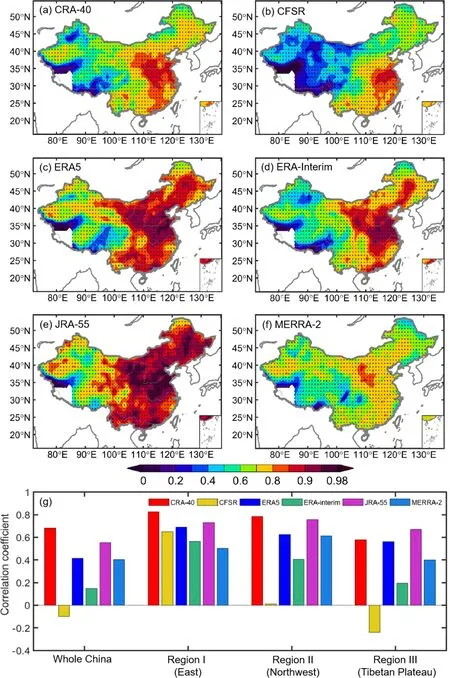
Fig.7.(a−f) Spatial distribution of the correlations between the observations and the reanalysis RH anomalies during 1979−2018 (1980−2018 for the MERRA-2) over China and (g) correlations of the regional mean RH anomalies.The stippled areas in (a−f) indicate statistical significance at the 5% level.
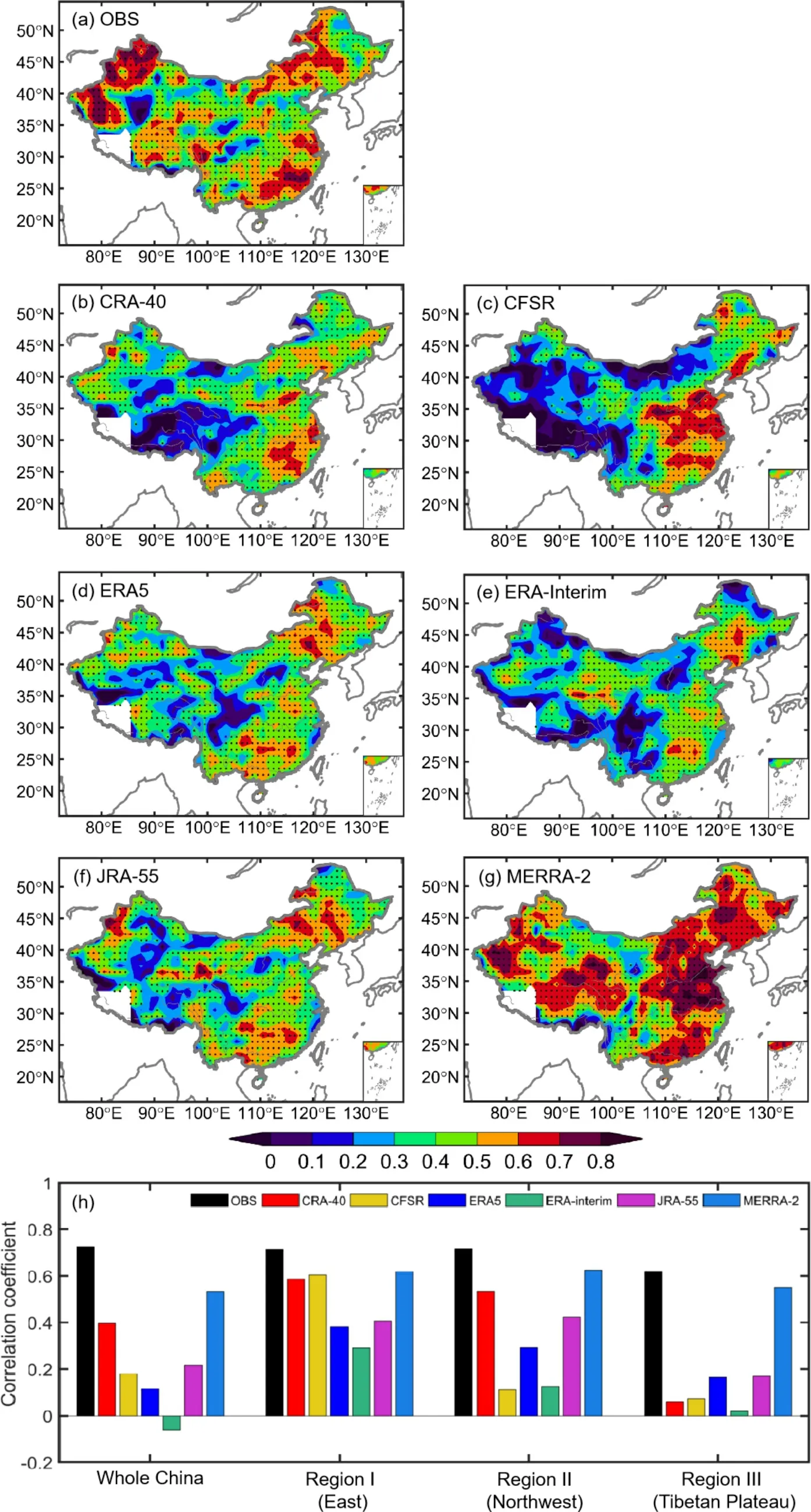
Fig.8.(a−g) Spatial distribution of the correlations between the GPCC precipitation and reanalysis RH during 1979−2018 (1980−2018 for the MERRA-2) over China,and (h)correlation coefficients of the regional-average precipitation and RH anomalies.The stippled areas in (a−g) indicate statistical significance at the 5% level.
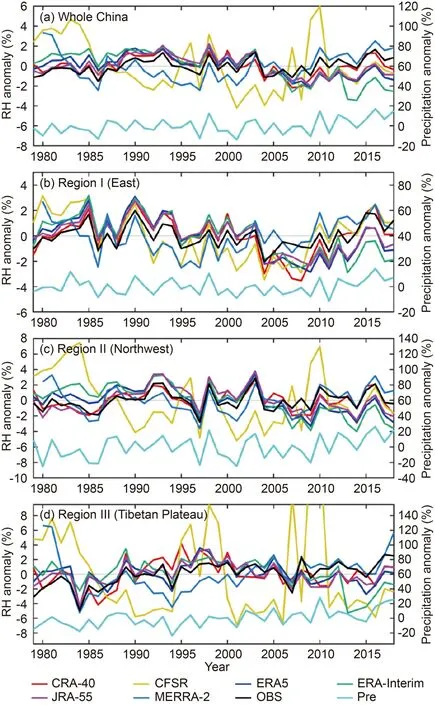
Fig.9.Time series of annual RH anomalies for the observations and the reanalyses averaged over (a) the whole of China and (b−d) the three subregions outlined in Fig.1 during 1979−2018 (1980−2018 for the MERRA-2).The anomalies (%) of observed precipitation (Pre) are also shown in cyan lines.
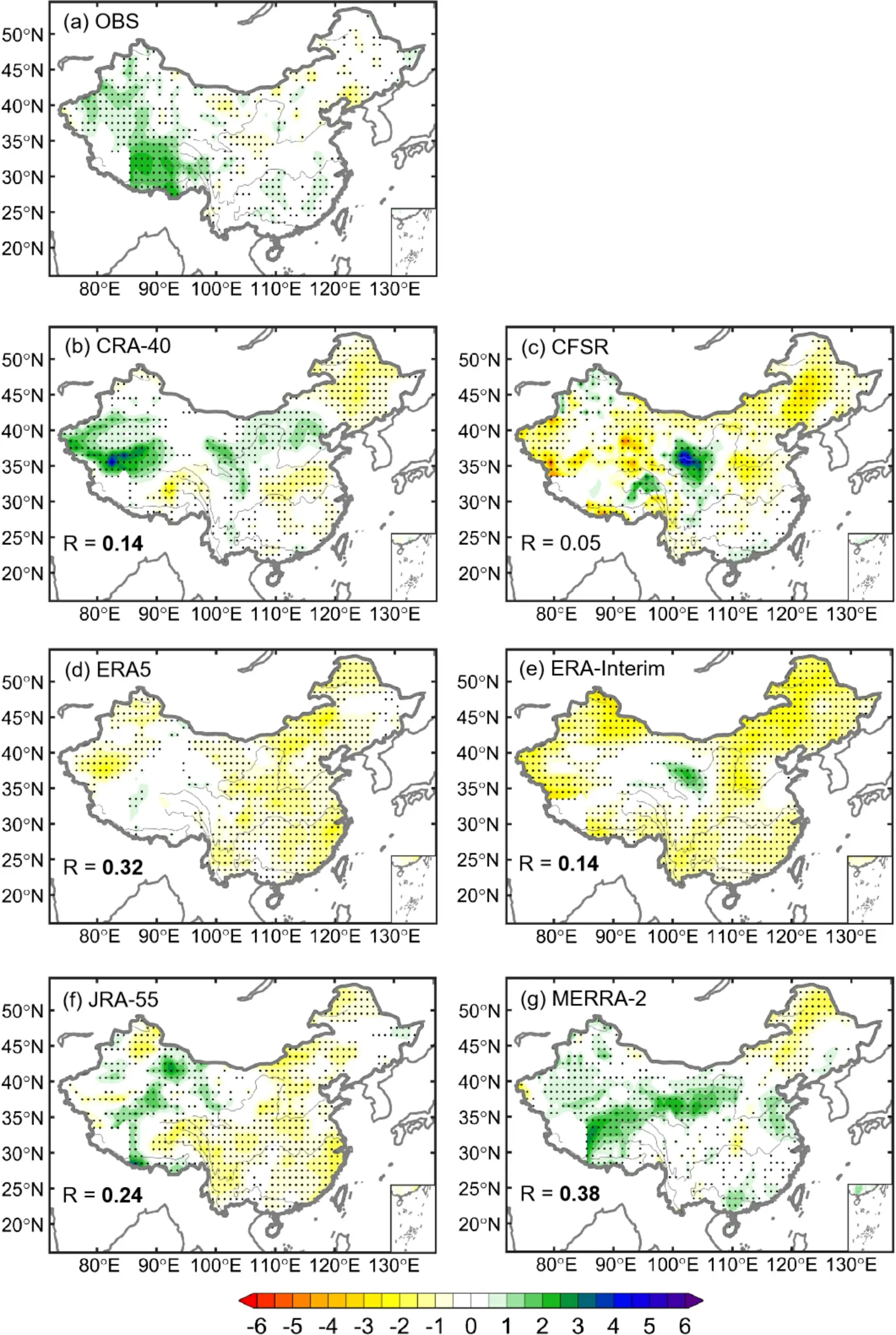
Fig.10.Distributions of the linear trends [% (10 yr)−1] of monthly RH anomalies estimated from the observations and reanalyses over China during 1979−2018 (1980−2018 for the MERRA-2).The stippled areas indicate the trend is statistically significant at the 5% level.The pattern correlation (R) between the reanalyses and the observations is also shown in (b−g).The bold numbers are statistically significant at the 5% level.
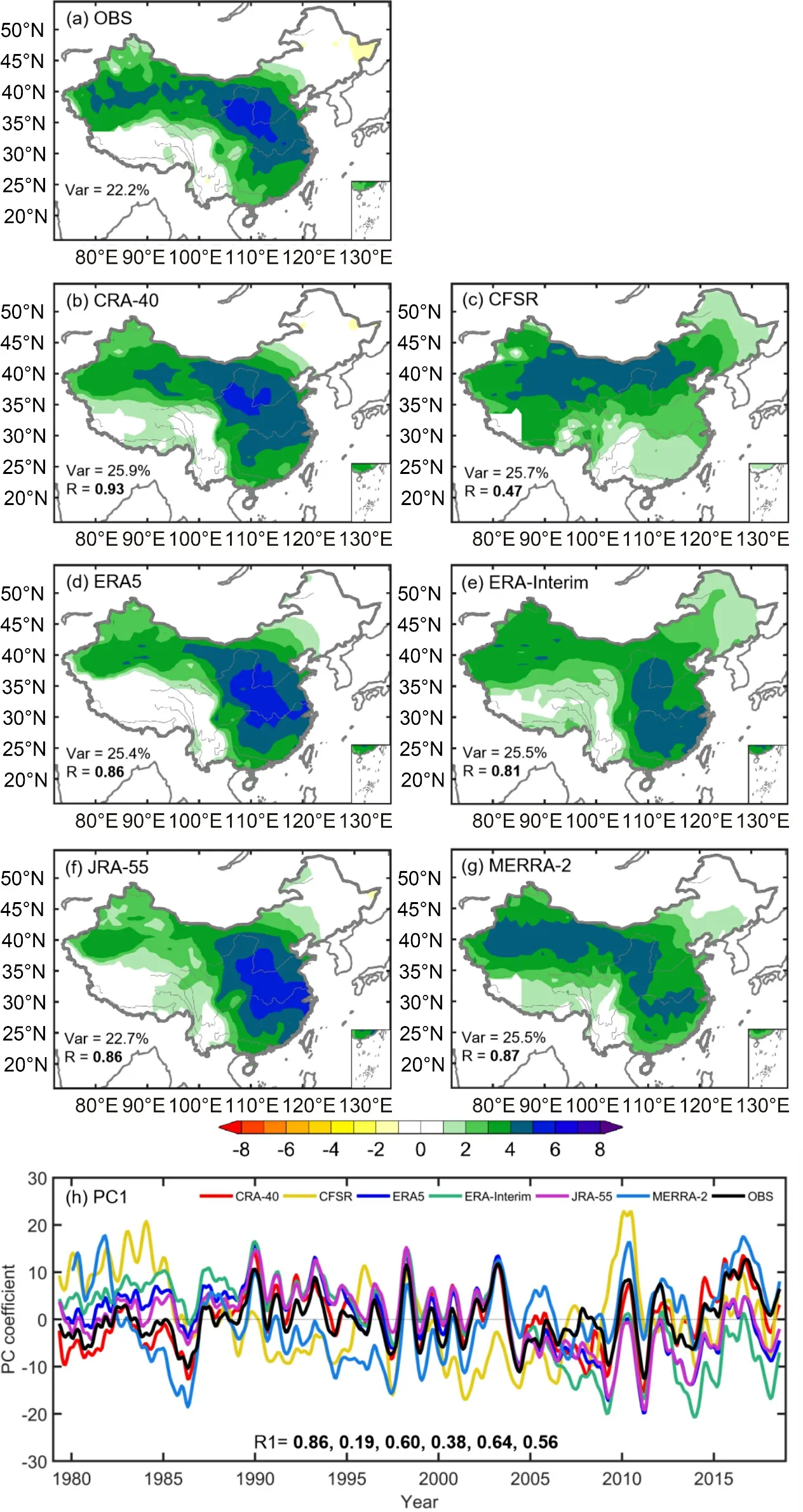
Fig.11.(a−g) First leading EOF and (h) its corresponding nine-point moving average principal component (PC) time series derived from observed and reanalysis RH monthly anomalies for 1979−2018 (1980−2018 for the MERRA-2).The monthly RH anomalies are normalized by the local standard deviation and square root of the cosine of the latitude in each grid box,respectively,before the EOF analysis.The explained percentage variance (Var) is shown in (a−g).Both the(R) pattern correlations are shown in (b−g),and the PC correlations (R1) between the observations and the reanalyses are shown in (h).The bold numbers are statistically significant at the 5% level.
The results show that most of the reanalysis products can reproduce the observed RH climatology for the annual,warm,and cold seasons well over China.Most reanalyses overestimate the observations by 15%−30% (difference of observation minus reanalysis) over the Tibetan Plateau but underestimate the observations by 5%−10% over most of northern China (especially less than 15% over northwestern China).Largely following the terrain features of China,the RMSE of the reanalyses with respect to the observations is within 4% for most of eastern China,but more than 10% in most of northwestern and southwestern China.The shapes of the histograms estimated from most reanalyses are roughly consistent with the observation-based result,and the CSFR performs relatively poorly among these reanalyses.
Most reanalyses,especially the CRA-40,ERA-5,and JRA-55,perform better in depicting the interannual variations seen in the observed surface RH (with a correlation of 0.5 or higher) over many regions of eastern China than in the west.Most of the reanalyses are unable to capture the weak upward trends in observed surface RH since 1979,and their RH trends differ substantially from each other.The CRA-40 performs well in depicting the interannual variations in observed RH while the MERRA-2 does relatively better to capture the observed RH trend patterns with comparable upward magnitudes over most of China.Among these current reanalysis products,the CFSR not only shows the largest bias with respect to the observations but also performs poorly in describing the interannual variations and long-term trends seen in the observed RH for most of China.An EOF analysis also suggests that the CRA-40 performs better than other reanalyses in capturing the first two leading EOF modes revealed by the observations.
Figure 13 shows the performance ranking of six reanalyses with respect to the observed RH over China (based on the statistical results from Tables 2 and 3 and Figs.2,7−12).Overall,the CRA-40 performs well in many aspects of reproducing the changes and variability in the observed RH over China while the CFSR preforms the worst among these reanalysis products.The results of this study can help us better understand the strengths and weaknesses of these commonly used reanalysis products,especially for the CRA-40,and thus facilitate their applications in the future.
It should be noted that the gridded observation data used in this study still contains some discontinuities over the areas covered by sparse stations,especially over the western Tibetan Plateau.Thus,it should be cautioned that the interpolated values over the western Tibetan Plateau will likely be less reliable.Despite the reliability or quality of the gridded observation data over western China,especially over the Tibetan Plateau and the Taklimakan desert,this study mainly focuses on the differences in the long-term mean,variations,and changes in surface RH between reanalysis products and the observations for a large scale in order to minimize the error induced from data regridding.Furthermore,the results of this study also suggest that without the input of homogenized observations,long-term reanalysis products will likely produce spurious and misleading changes.Therefore,it would be better to devote more effort to generate homogenized input data from multiple sources for future reanalysis products.
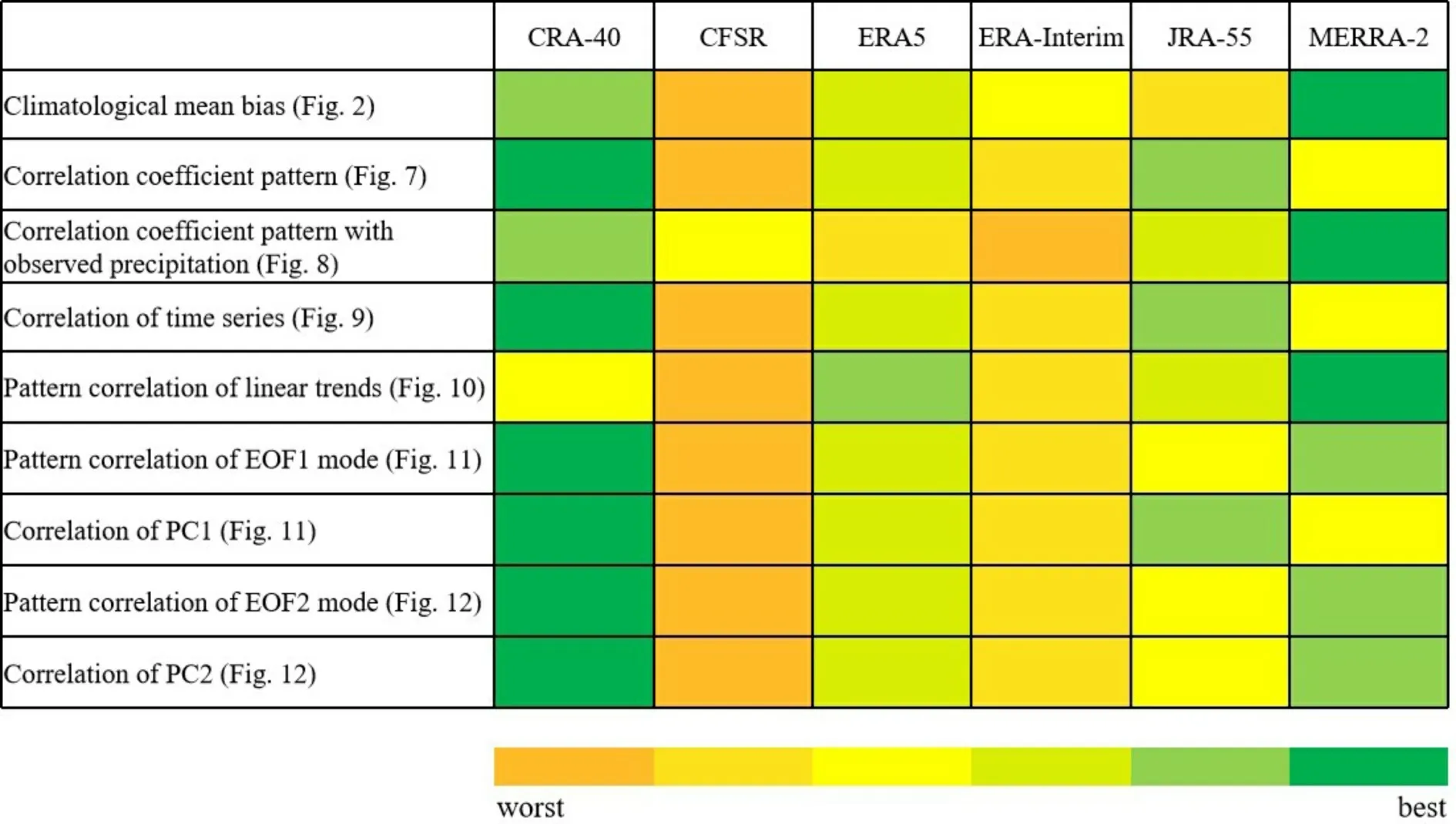
Fig.13.Performance of six reanalyses in reproducing observed RH over China during 1979−2018 (1980−2018 for the MERRA-2) based on biases of long-term mean (Fig.2),pattern correlations (Fig.7),correlation with the observation-based precipitation (Fig.8),correlations of regional mean variations (Fig.9),pattern correlations of linear trends (Fig.10),pattern and PCs correlations of the first two-leading EOF modes (Figs.11 and 12).
Acknowledgements.The CRA-40 data were provided by the China Meteorological Administration (CMA).The CFSR,MERRA-2,and JRA-55 were obtained from the NASA Center for Climate Simulation/Goddard Space Flight Center (https://esgf.nccs.nasa.gov/).The ERA5 data were obtained from the Copernicus Climate Change Service (C3S) Climate Data Store,and the ERA-interim data were obtained from the ECMWF Data Server athttp://apps.ecmwf.int/datasets/.This work was supported by grants from the Strategic Priority Research Program of Chinese Academy of Sciences (Grant Nos.XDA19030402 and XDA19030401),the China Meteorological Administration Special Public Welfare Research Fund (Grant No.GYHY201506002),the National Natural Science Foundation of China (Grant Nos.41675094,41975115),the Natural Science Foundation of Shaanxi Province (Grant No.2021JQ-166),Chinese Universities Scientific Fund (Grant No.2452019224),and Open Research Fund of Key Laboratory of the Loess Plateau Soil Erosion and Water Process and Control,Ministry of Water Resources of China (Grant No.HTGY202002).
杂志排行
Advances in Atmospheric Sciences的其它文章
- Optimal Gridding Process for GMI Brightness Temperature Using the Backus−Gilbert Method
- A Case Study on MJO Energy Transport Path in a Local Multi-scale Interaction Framework
- Robust Solution for Boundary Layer Height Detections with Coherent Doppler Wind Lidar
- An Observational Study on the Local Climate Effect of the Shangyi Wind Farm in Hebei Province
- Effect of the Vertical Diffusion of Moisture in the Planetary Boundary Layer on an Idealized Tropical Cyclone
- Implications from Subseasonal Prediction Skills of the Prolonged Heavy Snow Event over Southern China in Early 2008
